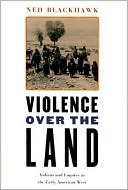I just finished reading Violence over the Land: Indians and Empires in the Early American West by Ned Blackhawk. The book focuses on the history of the Indian tribes of the Great Basin, a very sad history very well told. Indeed, the book cover lists five prizes for American history that the book has won for its author, a professor at Yale University who is himself a member of one of the tribes he discusses, the Shoshone.
I have some experience with Apache, Navajo, Hopi and Pueblo Indians -- the tribes that occupy the lands to the south of the Great Basin. I have fairly recently read The Pueblo Revolt: The Secret Rebellion that Drove the Spaniards Out of the Southwest by David Roberts and The Comanche Empire by Pekka Hamalainen. This book complements those, providing a broader view of the history of the South West.
 |
| The Great Basin and the Indian Cultures that inhabited it. |
The book deals with Utes, some of whom became early equestrians, the Paiutes, who generally did not, and the Shoshone, most of whom did not. All of them suffered from diseases. All of them saw the environment in which they lived deteriorate. The deterioration was caused by the over hunting for fur and eventually for meat, by the introduction of grazing livestock, and eventually by the environmental destruction from mining, and from commercial hunters, and from wagon trains first passing through the Great Basin and then colonizing it.
The European Americans were ultimately an irresistible force, and the history is ultimately a tragedy as the Indian nations were forced to adapt to a world imposed on the lands that they had owned, a world in which they were all too often the despised outsiders. Certainly one of the important values of this book is the demonstration that the process was a violent one in which the violence was often directed at Indians. The Indians were attacked, killed, mutilated, and enslaved, often by other Indians. They fought back as well.
I think another virtue of the book is that it treats Indians as serious actors, seeking to understand the different strategies that they adopted to deal with the problems that they faced. Often they failed to understand the threats that their tribes and their cultures faced -- how could they. Sometimes one wonders how Blackhawk knew what they, the historical Indians, thought. Indeed, I suspect that there was more "muddling through" than Blackhawk implies. However, it is important to realize that there were very smart and very competent people among these Indians and that they were working very hard to find ways to deal with the deteriorating environment and the encroaching whites.
The Americans come off rather badly, racist and duplicitous. American officials made treaty after treaty, breaking each as it became convenient to do so. They depended on increasingly superior armed force to drive the Indians into smaller and smaller, less and less valuable reservations. The best of the Americans forced Indian children into boarding schools and forced Indian adults into wage slavery on farms, ranches and mines. While they were consciously committing cultural genocide, they were also offering routes by which Indians could survive in the world which was surely coming.
The final chapter is interesting as it portrayed Indians seeking to find economic niches in the white world in which to work to survive, while retaining some hunting and gathering techniques, and holding on to some cultural ceremonies and as far as possible to family and community connections.
I think this is an important book. I also found many sentences, paragraphs and pages so well written as to force me to think and feel with the author!

No comments:
Post a Comment